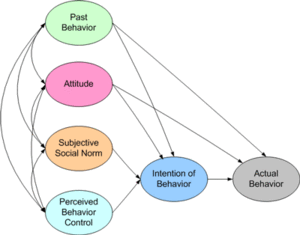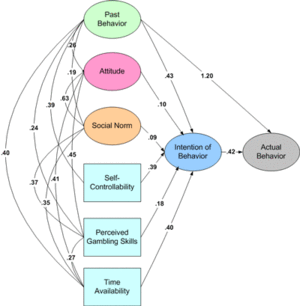What guides the decision to gamble? In their theory of reasoned action, Fishbein and Ajzen (1975) suggested that attitudes and knowledge of social norms indirectly affect what we do by influencing our behavioral intentions, which in turn directly affect our behavior. Research has since modified this theory by suggesting that our past behavior and our perceptions of behavioral self-control also influence our intentions to behave and further, that our past behavior and attitudes, together with behavioral intentions, directly affect our behavior (Oh & Hsu, 2001). Figure 1 displays this modified theory.
Figure 1: Modified Theory of Reasoned Action (Oh & Hsu, 2001)
Oh and Hsu examined the applicability of this modified theory of gambling behavior by phoning 2,700 randomly selected potential participants and identifying “current gamblers” (i.e. individuals who reported gambling in the past 12 months). Using systematic probability sampling methods1 developed in previous research, the authors identified and then mailed questionnaires to 485 Iowan gamblers who agreed to participate in the study. Gamblers were enticed to participate in the two phase study by the possibility of winning a $100 lottery prize. The first phase of the study consisted of a self-administered questionnaire which assessed past gambling behavior, attitudes, social norms, perceived behavioral control (i.e., budgetary affordability, self-controllability, perceived gambling skills, time availability), and behavioral intentions; 352 (73%) individuals returned the questionnaire. Researchers mailed participants who completed Phase One a second questionnaire two months later so that they could record changes in gambling behaviors and attitudes. Two hundred twenty six (64%; 145 female) individuals completed Phase Two.2 Oh and Hsu conducted a path analysis3 to determine three things: (1) the ability of behavioral intentions, attitudes, and past behavior to independently predict behavior, (2) the ability of past behavior, attitudes, social norms, and perceived self-control to predict behavior intentions, and (3) the degree of inter-relatedness of the factors: past behavior, attitudes, social norms, and perceived self-control. The authors expected all links represented in Figure 1 to be statistically significant.
Figure 2 shows that the paths predicted by Figure 1 were significant, except for the attitude to behavior path and the budgetary affordability4 to behavioral intention path. Thus, past behavior and behavioral intentions had direct positive relationships with actual behavior. Past behavior, attitude, knowledge of social norms, and measures of behavioral self-control had direct positive relationships with behavioral intentions. The inter-relatedness among the factors was low to moderate.
Figure 2: Significant Path Coefficients for the Modified Theory of Reasoned Action (Oh & Hsu, 2001)
Some methodological concerns include the low overall response rate and the narrowly recruited sample. Participants were from select areas in Iowa and women dominated the final sample. Taken together, these concerns might limit the capacity to generalize these findings to other place or to men. The use of lottery enticement to gain participants is questionable, particularly since the authors did not formally assess the actual number of pathological gamblers (PGs) with any conventional measures; consequently, the authors do not know if they put some individuals at unnecessary risk. The authors suggest, however, that this was not the case. They report that PGs probably did not contaminate the sample because of the moderate rate of abstinence and the overall low reported rate of gambling; only one individual reported gambling more than once in two days. Thus, while fortunately the risks associated with the lottery incentive technique might have been minimal, the findings reported by Oh and Hsu also might not apply to individuals with gambling problems.
This research fills an important void in our collective understanding of decision-making processes surrounding gambling behavior. Further, it moves towards an expansion of theoretically-derived research agendas by integrating a social psychological theory of behavior and the applied assessment of gambling. More inter-disciplinary and translational research between basic theoretical and applied science is key to the advancement of the field. Doing so will shed light on cognitive and behavioral processes that researchers and treatment providers could one day use to distinguish problem from non-problem gamblers. Attitude, social norms, past behavior, and perceptions of self-control indirectly affect individuals’ behavior through the development of behavioral intentions. Together, behavioral intentions and past behavior direct behavioral choices. Thus, the past, or habit, might direct gambling participation as much as conscious choice. Whether or not this relationship varies depending on pathology remains to be determined.
Comments on this article can be addressed to Debi LaPlante.
Notes
1. Systematic probability sampling uses pre-determined intervals to identify appropriate sampling units. For example, researchers might choose to select every third potential participant from a population of interest. In this study, the authors reported that they sampled based upon geographic distributions of gamblers identified by Hsu (1997).
2. Phase One to Phase Two dropouts did not differ from individuals who chose to participate in Phase Two on any tested demographic or attitudinal variables.
3. Path analysis is a statistical technique that allows for the testing of directional predictions without requiring direct variable manipulation.
4. Budgetary affordability was not included in this diagram because the path coefficient to behavioral intentions from budgetary affordability was not significant.
References
Fishbein, M., & Ajzen, I. (1975). Belief, Attitude, Intention, and Behavior: An Introduction to Theory and Research. Reading, MA: Addison-Wesley.
Oh, H., & Hsu, C. H. C. (2001). Volitional degrees of gambling behaviors. Annals of Tourism Research, 28(3), 618-637.






